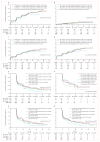Incidence and clearance of genital human papillomavirus infection in men (HIM): a cohort study
- PMID: 21367446
- PMCID: PMC3231998
- DOI: 10.1016/S0140-6736(10)62342-2
Incidence and clearance of genital human papillomavirus infection in men (HIM): a cohort study
Erratum in
- Lancet. 2011 Jun 11;377(9782):2006
Abstract
Background: Human papillomaviruses (HPVs) cause genital warts and cancers in men. The natural history of HPV infection in men is largely unknown, and that information is needed to inform prevention strategies. The goal in this study was to estimate incidence and clearance of type-specific genital HPV infection in men, and to assess the associated factors.
Methods: Men (aged 18-70 years), residing in Brazil, Mexico, and the USA, who were HIV negative and reported no history of cancer were recruited from the general population, universities, and organised health-care systems. They were assessed every 6 months for a median follow-up of 27·5 months (18·0-31·2). Specimens from the coronal sulcus, glans penis, shaft, and scrotum were obtained for the assessment of the status of HPV genotypes.
Findings: In 1159 men, the incidence of a new genital HPV infection was 38·4 per 1000 person months (95% CI 34·3-43·0). Oncogenic HPV infection was significantly associated with having a high number of lifetime female sexual partners (hazard ratio 2·40, 1·38-4·18, for at least 50 partners vs not more than one partner), and number of male anal-sexual partners (2·57, 1·46-4·49, for at least three male partners vs no recent partners). Median duration of HPV infection was 7·52 months (6·80-8·61) for any HPV and 12·19 months (7·16-18·17) for HPV 16. Clearance of oncogenic HPV infection decreased in men with a high number of lifetime female partners (0·49, 0·31-0·76, for at least 50 female partners vs not more than one partner), and in men in Brazil (0·71, 0·56-0·91) and Mexico (0·73, 0·57-0·94) compared with the USA. Clearance of oncogenic HPV was more rapid with increasing age (1·02, 1·01-1·03).
Interpretation: The data from this study are useful for the development of realistic cost-effectiveness models for male HPV vaccination internationally.
Funding: National Cancer Institute.
Copyright © 2011 Elsevier Ltd. All rights reserved.
Conflict of interest statement
ARG receives support from Merck, the manufacturer of the HPV vaccine, for the phase 3 Quadrivalent HPV Vaccine Trial among Men (Tampa, FL, USA); and is also a consultant to Merck, a member of the Merck Male HPV Advisory Board, and is on the speaker’s bureau for Merck. LLV is a consultant for Merck. The other authors declare that they have no potential conflicts of interest.
Figures

Comment in
-
Genital infection with HPV in men: research into practice.Lancet. 2011 Mar 12;377(9769):881-3. doi: 10.1016/S0140-6736(11)60277-8. Epub 2011 Feb 28. Lancet. 2011. PMID: 21367447 No abstract available.
-
Dynamics of genital human papillomavirus (HPV) infections among males eventually being uncovered.Asian J Androl. 2011 May;13(3):361-2. doi: 10.1038/aja.2011.24. Epub 2011 Apr 18. Asian J Androl. 2011. PMID: 21499279 Free PMC article. No abstract available.
References
-
- American Cancer Society. Cancer facts and figures. Atlanta: American Cancer Society; 2009.
-
- Koshiol JE, Laurent SA, Pimenta JM. Rate and predictors of new genital warts claims and genital warts–related healthcare utilization among privately insured patients in the United States. Sex Transm Dis Dec. 2004;31:748–52. - PubMed
-
- Buckley JD, Doll R, Harris RW, Vessey MP, Williams PT. Case-control study of the husbands of women with dysplasia or carcinoma of the cervix uteri. Lancet. 1981;2:1010–15. - PubMed
-
- Zunzunegui MV, King MC, Coria CF, Charlet J. Male influences on cervical cancer risk. Am J Epidemiol. 1986;123:302–07. - PubMed
Publication types
MeSH terms
Substances
Grants and funding
LinkOut - more resources
Full Text Sources

